I hope you’ve enjoyed this “Exploring Permaculture” series thus far. My sketches aren’t getting any better, but I haven’t busted out the crayons yet, so I’ll celebrate the small victories as I may. In today’s post, “Exploring Permaculture: Site Design,” our final chapter of this series, we’ll summarize our findings and design our plan of attack come spring. I’m about as excited as can be, hope you are too!
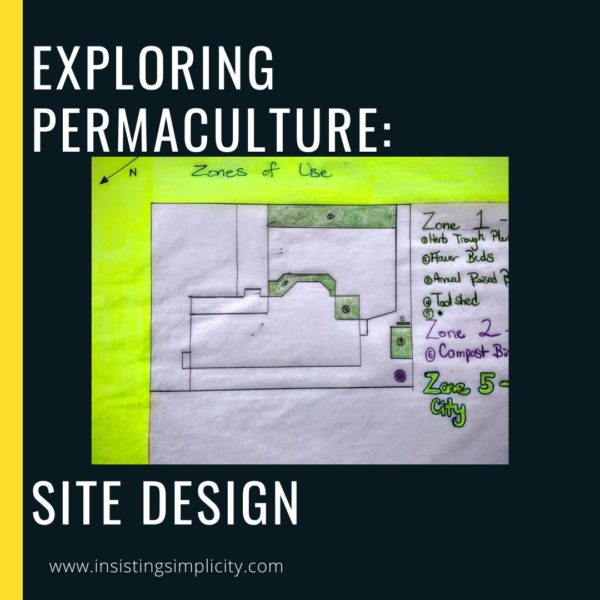
Zones of Use
In discussing zones of use as they pertain to our little condo on the asphalt, it might be helpful to quickly define this fundamental permaculture concept. Without getting bogged down by the tedium of which things go where, think of zones of use from a high level.
Each zone (1 – 5) corresponds to both distance from the homestead and, more importantly, frequency of care. Put simply, zones can be laid out by asking oneself:
1) How far is this blank (should this blank be) from my kitchen?
2) How often do I need to tend/water/weed/prune/etc. this blank?
Now, let’s add to this base concept.
Related:
Zone 1
Zone 1 encompasses the area nearest the kitchen. Frequented daily, these are high attention areas. Herbs, annuals, raised beds, etc. are standard bearers. Storage areas, water catchment and irrigation systems may also be found in Zone 1.
Zone 2
Zone 2 elements require slightly less attention, maybe a few or handful of times per week. Dwarf and semi-dwarf fruiting trees, farm animals, compost bins, fungi logs, beehives and additional outbuilding storage can all be found here. Likely, a homestead with livestock versus one without, will approach Zone 2 quite differently.
Zone 3
Zone 3 (hopefully) consists of one’s bumper crop. It is frequented less often than Zone 2 and will most resemble a traditional farm. Yields from Zone 3 provide inputs, which may ultimately be brought to market as raw or finished goods.
Zone 4
Zone 4 is least managed, flirting with wilderness. Foraging for nuts, berries and fungi are Zone 4 specialties. Wildlife viewing and outdoor recreation also typify Zone 4.
Zone 5
Zone 5 is wilderness. Wear orange, bring a fishin’ rod type stuff.
Or… something completely different in an urban landscape…
Our Zones of Use Analysis
Feast your eyes on this beauty! (You may need sunglasses, I used a highlighter)

Zone 1
For our undersized urban plot, Zone 1 is king. When I conceptualize this site, I like to imagine Zone 1 begins the moment one crosses the backdoor threshold. A modestly sized, semi-private back porch greats you (above #4 tool shed). This should be the nerve center of outdoor agricultural and recreational activities.
The hanging trough planter (on-railing install), and any other planters situated here command one’s attention. Plants here will get full to partial sun exposure, while providing us humans with additional privacy and a pleasant ambiance. Last season, we utilized the trough planter for strawberries. They were delicious! Buuuuuut, I think we plucked maybe a half dozen all season. It may be sensible to switch it up this year. For such a prime sun location, we may be better served with a higher yielding plant, or maybe just an alternate strawberry variety.
From this vantage point, we can check-in on our herb trough planter (#1) and small raised bed (#3). We put a bunch of different plants in the bed last year – with varying degrees of success. This season, we may choose to sow it primarily with leafy vegetables.
Beneath the spiral fire escape (adjacent to #4 tool shed), our blueberry bush resides. I’ve observed an unsettling situation unfolding over the winter. Water run-off is eroding the soil directly adjacent to the bush. Continued unabated, this will not be great for our little blue… What to do…? Ahhh!
The tomato planters will be once again placed along the edge of the yard at the southern corner of building, position A for sun exposure.
Flower beds (#2), of course, will be loaded up with fun stuff… I hope the sunflowers are even more spectacular this year!
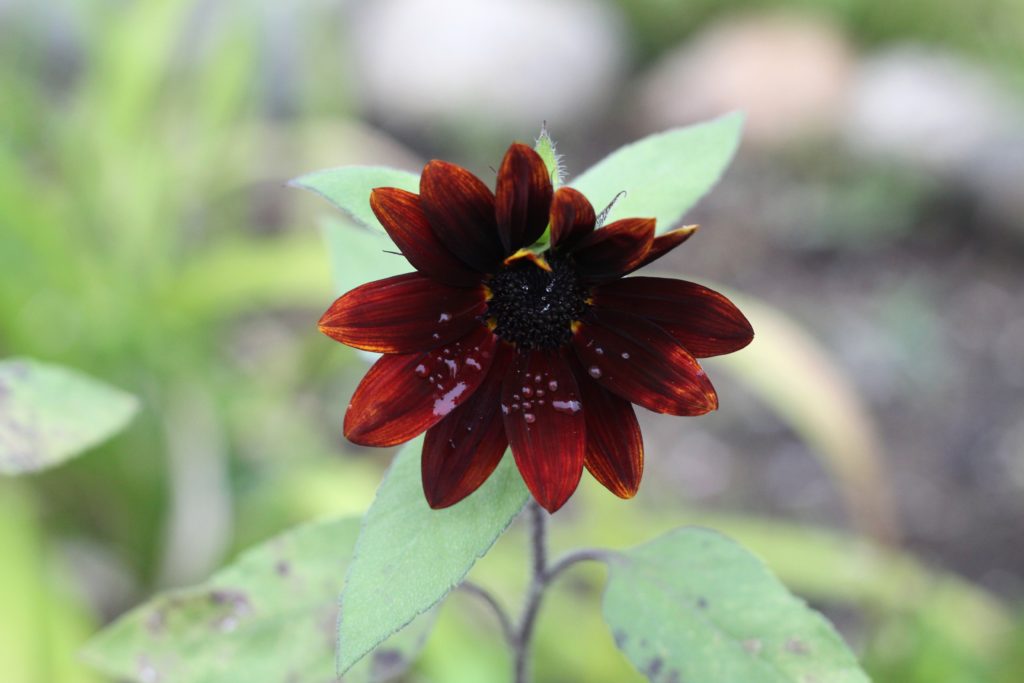
Zone 2
Zone 2 elements consist of our compost bin located at the western corner of the property, which is the shadiest and dampest spot on the property. Not ideal for sun-loving plants due to the surrounding structures, but a decent spot to tuck away a sizable compost bin. No animals to speak of (beyond a couple neighborhood bunnies I’ve seen!), so Zone 2 is pretty simple.
Zone 5
We’re skipping straight to Zone 5 to include our surrounding community. I don’t think I’ll be spending too much time foraging the neighborhood for nuts and other edibles, but I suppose one could.
For our purposes, Zone 5 includes our near-by farmer’s markets. In the winter, we are blessed to have a great one a quick bike ride up the street and in the summer, within walking distance.
For recreation and artistic inspiration, we may also look to Zone 5 as a resource. Walks with a camera and a pal are magnificent; the bike path is great for running and cycling.
Summary of Constraints and Opportunities
Like any site, this property poses unique challenges, but also huge potential. The limited space will always be a factor. We don’t necessarily want a farm on a city block aesthetic, nor a wild, dense agro-forest, but productive plants are always a joy. We’d like to strike a balance between form and function, asking ourselves: What share of the limited space will be productive versus decorative?
I for sure won’t lose any sleep over this “problem” and maybe we can find creative ways to satisfy both goals simultaneously.
With two sides of the property situated on-street, cars and pedestrians make privacy concerns front of mind. An opaque fence or natural hedge does not appeal to our tastes, but some level of privacy achieved with mindful placement of plants and trees are a different story. The rose bush and dogwood tree already provide some welcomed cover, but maybe we can bolster their efforts with additional reinforcements, like bushes, shrubs or tall grasses.
Remember that crappy soil? Yeah, it’s still crappy. We could spend great resources to properly bring the soil back to health. This is a noble project, but not one we want to endeavor. As band-aid solutions, we will continue to utilize bagged loam, planters and soil transplants, while continuing to fertilize the soil with compost and mulch. Over time, we’ll cultivate healthier soil, but we need to be realistic with our expectations.
Our greatest opportunity may be the fact that we (and the folks before us) did much of the heavy lifting already. And, in deference to Fukuoka’s ‘do-nothing farmer,’ the long-term goal for any of our permaculture designs should be to make systems more efficient and productive each year.
So, for this site, we don’t necessarily want to do a whole lot more, in fact, maybe we can find ways to do less…
2020 Action Plan
So, what are we ‘do-nothing’ farmers going to do then?
Sit, hang, watch the birds?
Well, maybe a bit more…
Let’s begin with that which started it all: The Tommies! Tomatoes will again be a main feature of our garden. This year, however, we’ll experiment with vertical gardening. Last season, I spent a great deal of time fashioning my “MacGyver”-esque tomato support structures. It was fun to play with the tomatoes and I do like MacGyver, but maybe we can work a bit smarter and increase our yields. I would like to fashion a trellis support structure that will both support the late-season weight of a half dozen mature tomato plants, while covering up an unsightly mess of utility wire jumble.
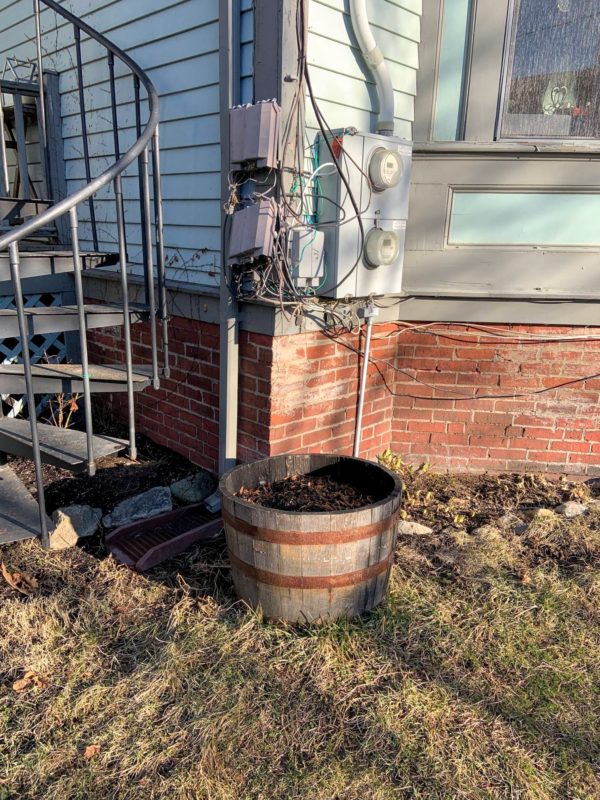
As 2019 came to an end, I “retired” the raised bed for the year adding leaves and compost. In retrospect, the raised bed wasn’t very raised at all. This year, I want to heap up the soil before planting.

Our flower beds will remain flower beds. We’re going to experiment more with pollinators and vegetation that may provide additional limited privacy and noise blocking.
With the addition of some floating planters and whatever we decide to put into the hanging trough planter, that pretty much sums up our urban permaculture landscape…
Stretch Goals
Well, I guess, it doesn’t sum things up entirely. We do have some stretch goals that would be amazing to get to this spring and summer, but we won’t fret if they go uncompleted.
We have discussed installing a water catchment system to harvest rain-water run-off. Remember that spot by the blueberry bush?
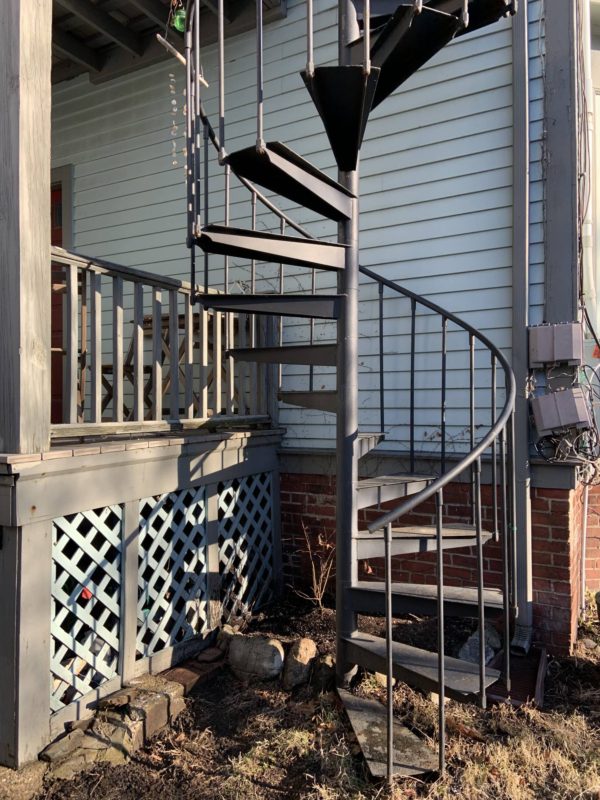
We could solve multiple birds with one stone, while getting us closer to true, unadulterated laziness. First, we would transplant the blueberry bush to a more suitable location. Next, we could construct a water catchment system and tuck it into this corner. We could design an irrigation system, drawing from the cistern(s) to directly supply the (water-loving) tomatoes. Theoretically we could flip a valve and watch the tommies have a drink, while we sat on the back porch sipping on a glass of wine. I like that idea!
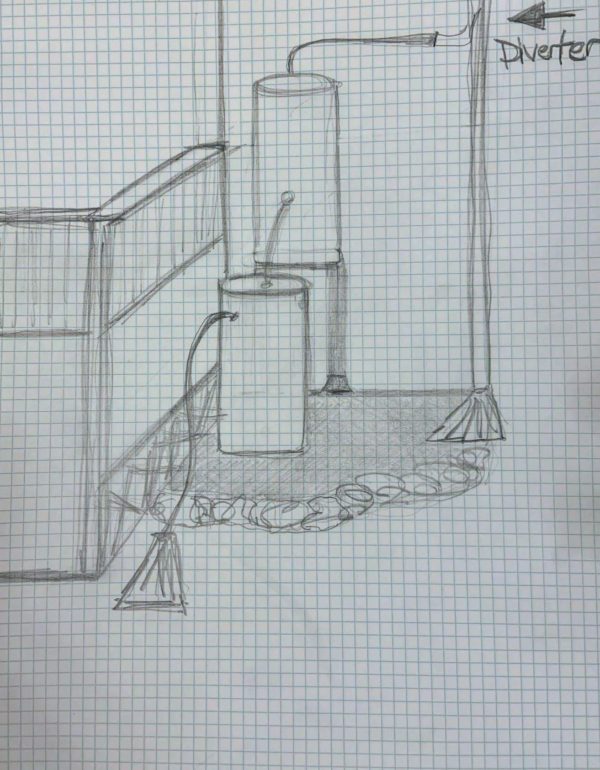
Lastly, an arbor or and archway somewhere on the property to support grapevine tickles our fancy somewhat. This idea is less thought out. I am also concerned that the poor soil would affect the quality of the grapes. I definitely don’t want to be growing things filled with toxins and pollutants. Need to stew on this one more.
On the Topic of Gary and Mitch
As we prepare for the 2020 growing season, let’s not forget about our 2019 efforts. As an experiment, we attempted to “over-winter” a McIntosh sapling named “Mitch the Mac” and grapevine scion named “Gary the Grape.” It brings me both joy and sadness to report on our experiments. It appears Mitch did not make it through the winter indoors.
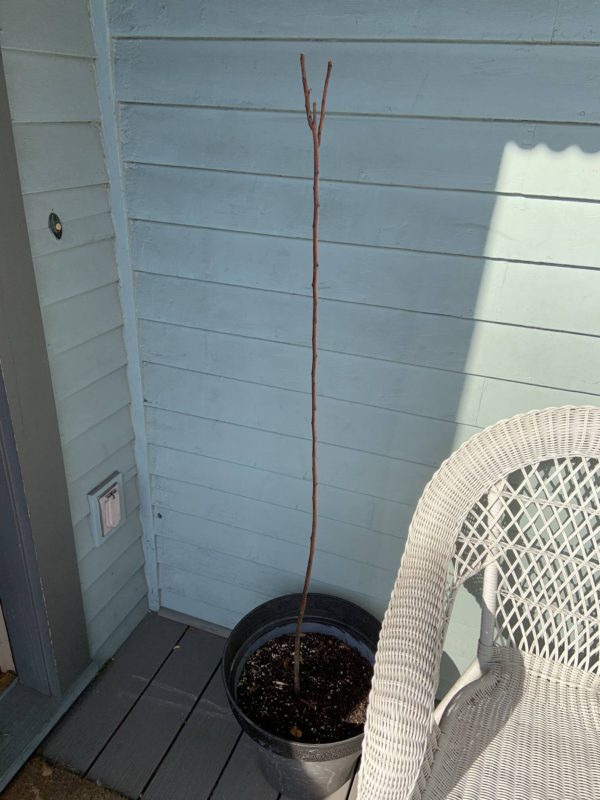
He was looking pretty rough when I plucked him from that bin at Ocean State Job Lot. I hoped that he would make it, but it looks like he dried out.
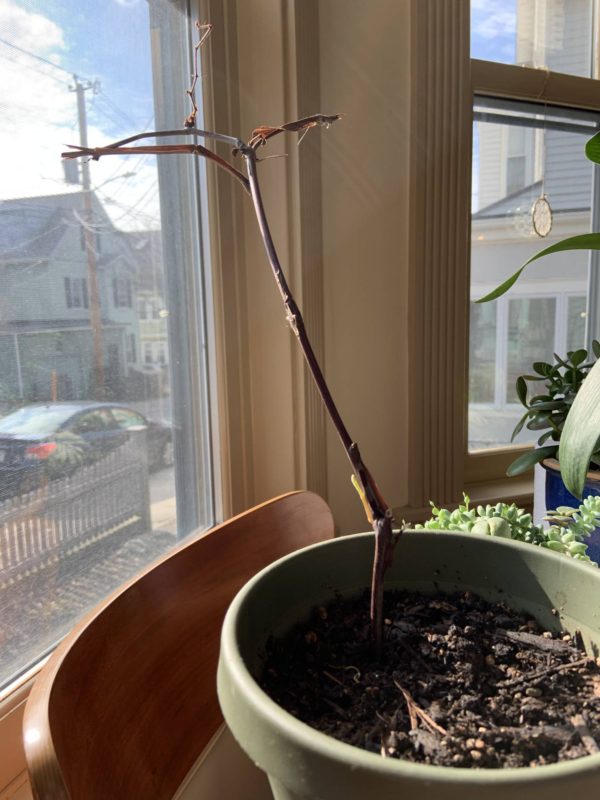
On a more positive note, Gary, the propagated grapevine scion experiment of 2019, is not only alive, but sprouting new growth as we speak!
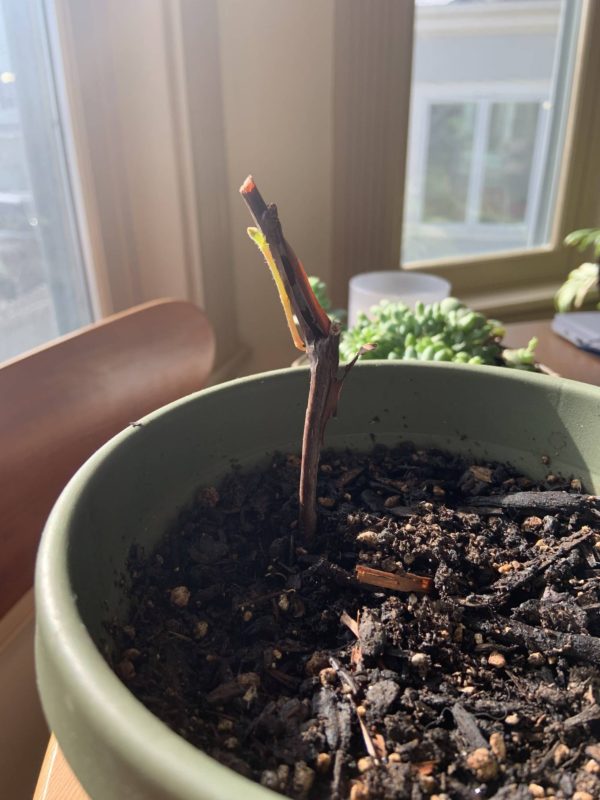
Go Gary, Go!
Now I’ve got to figure out what the heck to do with him!
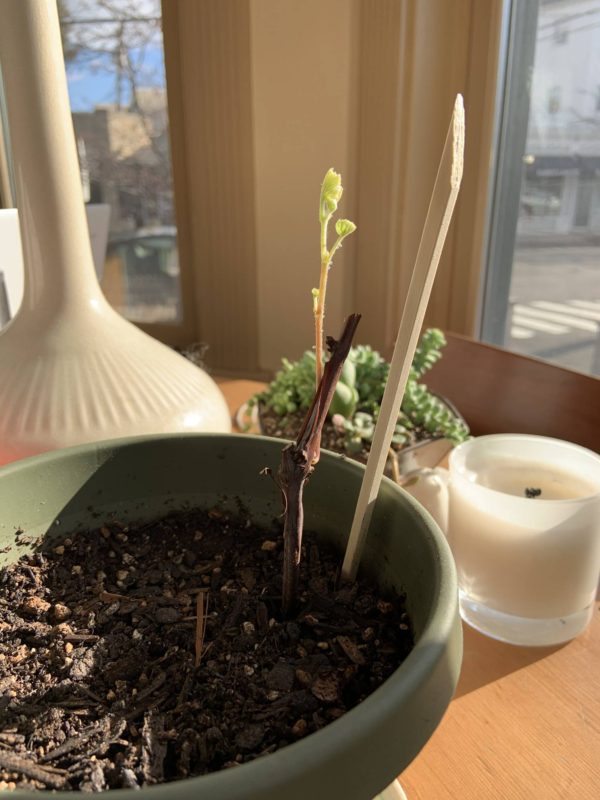
Conclusion
Here, in the greater Boston area, days of 30-something degree weather will soon turn over to 40-something degree weather. Soon thereafter, the magic happens! We’re excited for a new season, hope you are too!
What are your garden plans?

